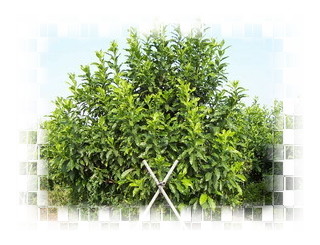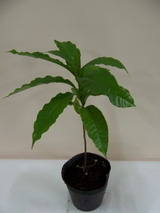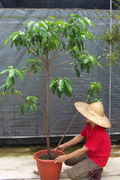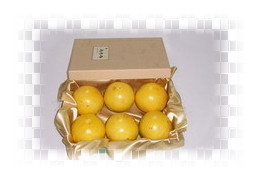| Science name: |
Pouteria caimito Radlk |
| Family |
Sapotaceae |
Description
|
The tree has a pyramidal or rounded
crown; is generally about 33 ft (10 m) high but may reach 115 ft (35 m)
in favorable situations. A gummy latex, white or reddish, exudes from wounds
in the bark. The leaves are alternate and highly variable; may be ovate-oblong,
obovate or elliptic; 4 to 8 in (10-20 cm) long, 1 1/4 to 2 3/8 in (3-6 cm)
wide; short-pointed at the apex, sometimes long-tapering at the base; smooth
or with a few scattered hairs. The flowers, borne singly or in groups of
2 to 5 in the leaf axils, are cylindrical, 4- to 5-lobed, white or greenish;
1/6 to 1/3 in (4-8 mm) long. The fruit, downy when young, is ovoid, elliptical
or round; 1 1/2 to 4 in (4-10 cm) long, sometimes having a short nipple
at the apex; with smooth, tough, pale-yellow skin when ripe and fragrant,
white, mucilaginous, translucent, mild-flavored, sweet or insipid pulp containing
1 to 4 oblong seeds, brown, with a pale hilum on one side. Until fully ripe,
the fruit is permeated with latex and is very gummy and astringent. |
| Origin and Distribution |
The abiu is a denizen of the headwaters
of the Amazon. It grows wild on the lower eastern slopes of the Andes from
southwestern Venezuela to Peru. It is often cultivated around Iquitos, Peru.
In Ecuador, it is common in the Province of Guayas and the fruits are sold
in the markets of Guayaquil. It is much grown around Para, Brazil; less
frequently near Rio de Janeiro, and to a limited extent at Bahia. In Colombia,
it is fairly common in the regions of Caqueta, Meta and Vaupes and it abounds
in the adjacent areas of Amazonas, Venezuela. It has been growing for many
years in Trinidad. |
| Varieties |
There is much variation in the form,
size and quality of the fruits of seedling trees, some having firm flesh,
some soft; and some are insipid, while others have agreeable flavor. At
Puerto Ospina, along the Putamayo River in Colombia, there is a type that
fruits in 4 years. The fruit is round and large. Near the River Inirida,
in Vaupes, Colombia, there is a type that bears in one year from seed, but
the fruits are small with little pulp. |
| Climate |
The abiu is strictly tropical or near-tropical.
It thrives best in a year-around warm and moist climate, yet Popenoe noted
that it does well in somewhat cooler Rio de Janeiro. In Peru it has not
been found above 2,000 ft (650 m), though in Colombia, it can be grown up
to an elevation of 6,000 ft (1,900 m). |
| Soil |
The tree is naturally suited to fertile,
wet soil. It is subject to chlorosis in the limestone of southern Florida. |
| Season |
The fruits are in season in March and
April in Ecuador. They are sold in some Brazilian markets from September
to April but only a few are seen in the much shorter season of February
and March at Bahia. Fruits have matured in October in Florida. The abiu
can be picked while underripe and firm for transport to markets. |
| Propagation and Culture |
In Brazil, the washed seeds are dried
in the shade and then planted, 3 together and 2 in (5 cm) deep in enriched
soil. They will germinate in 15 to 20 days. When the seedlings are 4 in
(10 cm) high, the 2 weakest are removed. The strong one is set out when
12 to 16 in (30-40 cm) high. Spacing is 17 x 20 ft (6 x 5 m). One year later,
the lower branches are pruned. Fruiting will begin in 3 years; will be substantial
in 5 years. |
| Pests and Diseases |
Actually, the fruit has little value
commercially because it is commonly damaged by small insects (bichos in
Spanish and Portuguese). In Brazil, the chief pests are said to be fruit
flies. |
| Food Uses |
In Colombia, people who wish to eat
the abiu. are advised to grease their lips beforehand to keep the gummy
latex from clinging to them. It is mostly eaten out-of-hand but, in Para,
some types are used to make ices and ice cream. |
| Wood |
The wood is dense and heavy, hard,
and valued for construction. |




